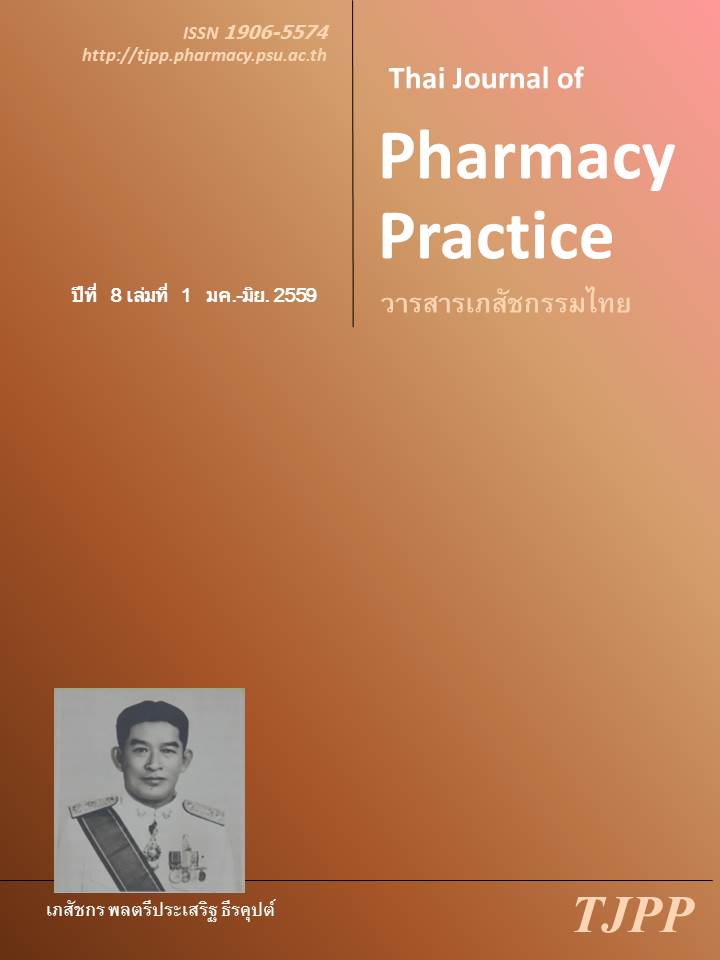กระบวนการผลิตแคบหมูที่มีผลต่อการตกมาตรฐานเรื่อง ปริมาณสารโพลาร์ในน้ำมันทอดซ้ำ: กรณีศึกษาจังหวัดแพร่
Main Article Content
บทคัดย่อ
วัตถุประสงค์ : เพื่อศึกษากระบวนการผลิตแคบหมูมีมันและไร้มัน และความสัมพันธ์ของกระบวนการดังกล่าวกับผลการตรวจสอบปริมาณสารโพลาร์ในน้ำมันทอดซ้ำที่ใช้ในกระบวนการผลิต วิธีการวิจัย : ผู้วิจัยสัมภาษณ์ผู้ประกอบการที่เลือกแบบเจาะจงจากสถานประกอบการ จำนวน 4 แห่งของจังหวัดแพร่ในประเด็นกระบวนการผลิตแคบหมูมีมันและไร้มัน ผู้วิจัยยังได้สังเกตวิธีการผลิตแต่ละขั้นตอน วัดปริมาณสารโพลาร์ในน้ำมันที่ใช้ตั้งแต่เริ่มต้นจนถึงรอบการเปลี่ยนน้ำมันใหม่ของแต่ละขั้นตอน ผลการวิจัย : กระบวนการผลิตแคบหมูมีมันและไร้มัน มี 3 ขั้นตอน คือ การรวน การอุ่น และการทอด จากการทดสอบปริมาณสารโพลาร์ พบว่า น้ำมันทอดซ้ำในการผลิตแคบหมูชนิดมีมันผ่านมาตรฐานทั้ง 9 ตัวอย่างที่ทดสอบ ส่วนน้ำมันทอดซ้ำในการผลิตแคบหมูชนิดไร้มันผ่านมาตรฐาน 37 ตัวอย่างจาก 50 ตัวอย่างที่ทดสอบ การตกมาตรฐานพบในขั้นตอนการรวน 5 ตัวอย่างจาก 13 ตัวอย่างที่ทดสอบ พบในขั้นตอนการอุ่น 7 ตัวอย่างจาก 23 ตัวอย่างที่ทดสอบ และพบในขั้นตอนการทอด 1 ตัวอย่างจาก 23 ตัวอย่างที่ทดสอบ ห้าปัจจัยจาก 12 ปัจจัยที่ศึกษามีความสัมพันธ์กับปริมาณสารโพลาร์ในน้ำมันที่เกินมาตรฐานอย่างมีนัยสำคัญทางสถิติ ได้แก่ ปริมาณของน้ำมันที่ใช้มาก อุณหภูมิที่ใช้ต่ำกว่า 150 องศาเซลเซียส เวลาที่ใช้นาน ปริมาณวัตถุดิบที่ใช้มาก และชนิดของกระทะที่ใช้เป็นสเตนเลส สรุป : การศึกษาพบสารโพลาร์เกินมาตรฐานในขั้นตอนรวนมากที่สุด ดังนั้นเพื่อหลีกเลี่ยงไม่ให้มีสารโพลาร์เกินมาตรฐาน ผู้ประกอบการควรใส่ใจการผลิตในขั้นตอนการรวน โดยควบคุมปริมาณน้ำมัน อุณหภูมิของน้ำมัน ปริมาณหมู เวลาที่ให้ความร้อน และชนิดของกระทะที่ใช้ให้มีความเหมาะสม
Article Details
ผลการวิจัยและความคิดเห็นที่ปรากฏในบทความถือเป็นความคิดเห็นและอยู่ในความรับผิดชอบของผู้นิพนธ์ มิใช่ความเห็นหรือความรับผิดชอบของกองบรรณาธิการ หรือคณะเภสัชศาสตร์ มหาวิทยาลัยสงขลานครินทร์ ทั้งนี้ไม่รวมความผิดพลาดอันเกิดจากการพิมพ์ บทความที่ได้รับการเผยแพร่โดยวารสารเภสัชกรรมไทยถือเป็นสิทธิ์ของวารสารฯ
เอกสารอ้างอิง
2. Ariyapitipan T. Change in oil during heating. Bangkok: The Lipid and Fat Science Research Center, Faculty of Allied Health Sciences, Chulalongkorn University; 2006.
3. Porasuphatana S, Weerakul J, Mahakunakron P, Tasssaneeyakul W, Assessment of polycyclic aromatic hydrocarbons and cytotoxicity of repeatedly used cooking oils. Khon Kaen: Faculty of Pharmaceutical Sciences; 2002.
4. Kitiwongsunthon W, Sriviriyanuparp W, Natnum- pong A, Ponrat S, Mujarintorn K. Revolution frying oil over the pan into The national agenda. 4th ed. Bangkok: Health Consumer Protection Program; 2016.
5. Notification of Public Health Ministerial Declaration No. 347 in 2012 on Food Manufacturing Methods Invovling the Use of Repeatedly Frying Oil. Royal Gazette No 129, special section 187D (Dec 13, 2012).
6. Komin W., Subsing B. The situation on the use of repeatedly used cooking oil in Thailand: The fact you need to know. 2nd ed. Bangkok: Health Consumer Protection Program; 2011.
7. Wittayarungruangsri J, Settapongwanich K. Dangers from reused cooking oil [online]. 2006. [cite 2015 Oct 18]. Available from: http://www.fda. moph.go.th/project/foodsafety/foodbackhome/news/2-2-49%20ภัยน้ำมันทอดซ้ำ.doc
8. Department of Nonformal Education. Part 2: Production processes of pork rinds from pork skin [online]. 2014. [cite 2015 Sep 4]. Available from: http://dnfe5.nfe.go.th/ilp/occupation/45303/45303_2.html.
9. Jitbunjerdkul S, Usawakesmanee W. Effect of repeated frying oil on The quality of fried oil and fried food: Study Case of Fried Chicken and
Chinese Doughnut. Hadyai: Prince of Songkla University; 2009 : 43.
10. Weerakul J. Study on cytotoxicity and genotoxicity of reperatedly fried cooking oils in cell culture [Master thesis]. Khon Kaen: Khon Kaen University; 2009.
11. Wikipedia. Stainless steel “thermal conductivity” [online]. 2015 [2015 Sep 4]. Available from: https:// th.wikipedia.org/wiki/Stainless steel.


